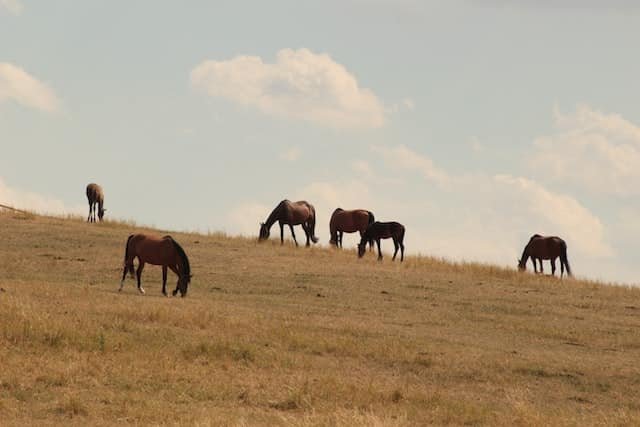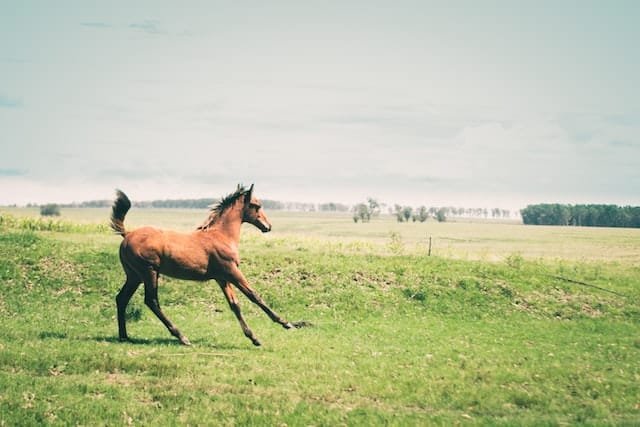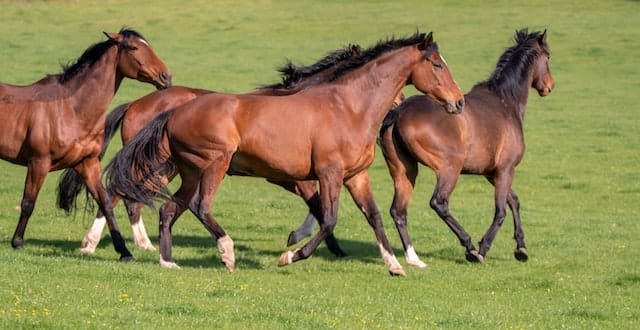The first ancestor of the horse lived on Earth 60 million years ago. From then to the modern horse, this species of animal has not only survived, it has thrived. And it has done so because it has been able to evolve and adapt to an ever-changing environment, a changing set of predators, and a wide range of climates.
So how have horses adapted to their environment? The most noticeable change in the horse over time has been its size. The first horse – the Eohippus – was no taller than a fox, but the modern horse – the Equus Caballus – can reach a height of six feet at the shoulder.
This increase in size is just one of many adaptations that have allowed horses to escape predators and travel long distances in search of food and water.
Now let’s look at what other changes the horse has been through over millions of years to adapt to its environment.
The Horse: From The Pre-historic to the Modern
The earliest known ancestor of the horse, the Eohippus, lived about 60 million years ago. The Eohippus was only about 14 – 15 inches tall – the height of a fox. The Eohippus was followed by the Orohippus, the Mesohippus, and a few other “hipusses” in the Eocene and Oligocene eras.
The Miocene and Pliocene eras saw a further evolution of the horse’s ancestors with the Mesohippus making way for Kalobatippus and the Parahippus. The Parahippus was the size of a small pony and with the Merychippus, finally, an animal resembling the modern horse was taking shape. Several more iterations later the modern horse genus called Equus Caballus was reached.
During this evolution, each successive genus or specie was taller and stronger than the previous, surviving by adapting to a changing environment. For instance, the earliest ancestors of the horse were adapted to living in forests. But 20 million years later (or 30 million years before our present time), the climate in North America began to change.
It started getting drier and forests started giving way to grasslands which eventually became the modern-day prairies. The Mesohippus, which lived in this era, adapted by growing grinding teeth (similar to molars) which were useful to grind hard grasses.

This continuous evolution and adaption to changing climates, environments and predators eventually gave way to Equus Caballus – the modern-day horse.
Colors and Camouflage
Before horses were domesticated, they had coats that helped them blend into their surroundings making it harder for predators to spot them. The dun gene, for example, is a pigment that ranges in color from light yellow to reddish brown and it was commonly found in wild horses.
This coat color provided good camouflage against the dry grasses and dirt of the steppes where these animals roamed. The coat also served as a form of protection from the harsh sun and biting insects.
Nowadays, domesticated horses come in a wide variety of coat colors – from black to white and every color in between. But the colors of domesticated horses are a reflection of selective breeding rather than that of a natural evolutionary process.
If you want to see a horse blend into its native surroundings you may have to visit the Khustain Nuruu National Park in Mongolia where the Mongolian wild horses or the Przewalski’s horses live in the wild. Here, their dun coat with pangaré features is perfect camouflage in the grey of the steppes.
Legs, Feet and Hooves: How they evolved
Modern horses, just like all of their ancestors, have long legs relative to their bodies. This has been the case from the start with the Eohippus. And so horses and their ancestors have always been adapted to running.
Horses are prey animals with a fight-or-flight instinct. And since horses are scared of many things, they lean more towards flight rather than fight. As a result, horses have always needed to run fast to escape predators. The long legs of early horses were, therefore, an adaptation that helped them survive.
Long legs also help the horse cover more distance in less time. This is one of the reasons why horses can run long distances.
The modern horse has powerful thigh muscles but no muscles below the knee. Instead, it has long tendons which connect the knee to the feet. This evolutionary adaptation allows the horse to easily move its legs while keeping them light for speed.
Another adaptation that allowed horses to outrun predators was the development of hooves in place of nails or claws. The hoof is a tough and keratinous outer covering that protects the horse’s foot. It is also an excellent shock absorber that helps horses run quickly and smoothly over rough terrain.
Despite its hard exterior, the hoof has some flexibility built into it. The hoof is circular but is an incomplete circle, giving it a crescent shape. In the opening is the flexible heel which allows slight changes to the horse’s hoof which are necessary as the angle at which weight falls on the hoof changes while the horse runs.
Teeth, Jaws and Digestion: Adapted for available food sources
The horse’s jaws and teeth have adapted as much to its environment as any other part of its body. A horse’s primary diet in the wild consists of grass. And so, their teeth have adapted to enable them to effectively eat and digest grass.
Adult horses have three incisor teeth, three pre-molar teeth, and three molar teeth on each side. And the upper and lower jaws have the exact same teeth formations and are mirror images of each other.
This construction permits the horse to cut (with incisors) and chew (with molars) the grass and vegetation to a point that it can be adequately processed in the stomach to extract the nutrients out of it.
Horses also have bacteria in the colon with which they can digest cellulose and extract further nutrients from the grass including protein. This is how horses get protein from hay and are able to satisfy their entire protein needs just from grass and hay.
This perfect anatomy for eating vegetation is one of the reasons why horses still eat a lot of hay even though they are domesticated.
Respiration and Circulation: For bursts of speed and running fast
A horse’s respiratory system, not unlike a human’s, is responsible for extracting oxygen from the air that the horse breathes. The circulatory system is responsible for delivering this oxygen to the body’s cells.
In a horse, the respiratory and circulatory systems are specially adapted for speed and endurance. A horse’s muscles often need oxygen in a hurry. This happens when the horse needs to suddenly start running as might happen in case a wild horse sees a predator or a racehorse starts a race.
To be able to urgently provide muscles with oxygen the horse’s spleen comes into the picture. A horse’s spleen stores extra red blood cells. When the horse breaks into a sudden run or after intense effort need extra oxygen, the spleen is squeezed and the stored red blood cells are released into the bloodstream. These cells carry the much-needed oxygen to the horse’s muscles. So, even a horse’s spleen has adapted to its environment and helped the horse survive its predators.
Eyesight, Smell & Hearing: Necessary for survival
In the wild, a horse needs all its senses to survive. This includes eyesight, hearing, smell and even touch and taste.
Danger is first picked up by sight and sound. It can also be picked up by the sense of smell. Because the horse has eyes on the sides of its head, it has a wide field of vision. Also, the horse’s eyes are able to work independently of each other. This allows the horse to see predators or other dangers approaching from any direction.
The only blind spot for a horse is directly behind it. This is why we should never approach a horse from behind.
Just like its eyes, a horse’s ears also work independently of each other. This allows the horse to pick up sound from virtually all directions. Likewise, smell is used to detect predators nearby or even bad food. This is another way how a horse has adapted to its environment.
Living in a herd: Strength in numbers
Wild horses live in herds. And there is safety in numbers. There are several advantages of living in a herd.
The most obvious advantage is that there are more eyes and ears to watch out for predators. A hard is also able to protect the young and vulnerable. For instance, when a herd travels, the young and old horses are placed in the middle of the herd for protection. The stronger, more able-bodied horses surround them.
On spotting a predator, the herd will band together and face the danger. The adult horses will start kicking and striking out with their front legs to scare away the predator. If that doesn’t work, the entire herd will take off running.
Even after domestication horses exhibit herd behavior and yearn for the companionship and social aspects of a herd. I guess, some basic instincts never go away.
Final Thoughts
Over 60 million years the horse has evolved from a small fox-like creature to the superb animal we know today. And how have horses adapted to their environment during this time? Remarkably well.
The horse has proven to be a true survivor. It has adapted to changing climates and environments. It has also adapted its body to suit the needs of the era. From its physiology to its anatomy to its social behavior, the horse has continuously evolved and in doing so, has survived and thrived!



